Liposuction Explained: What to Expect & Costs
Liposuction is a widely chosen cosmetic surgery for removing stubborn fat from targeted areas when diet and exercise fall short. This overview explains who makes a good candidate, how the procedure works, recovery timelines, potential risks, and typical costs — helping you decide if liposuction fits your body-contouring goals.

Liposuction is a surgical method used to remove localized fat deposits and refine body contours. Unlike weight-loss procedures, its primary aim is sculpting — eliminating pockets of fat that resist diet and exercise to create smoother, more balanced proportions.
How liposuction is performed
The procedure can be done under local anesthesia with sedation or general anesthesia, depending on how many areas are treated and the patient’s preferences. Small incisions are made near the target zones, and a thin tube called a cannula is inserted. The surgeon breaks up and suctions out excess fat using manual or powered techniques. Modern approaches may incorporate tumescent fluid to minimize bleeding and swelling, ultrasound-assisted or laser-assisted technologies to loosen fat, and careful contouring to improve final shape.
It is important to understand that liposuction removes fat cells from treated areas, but it is not intended as a method for major weight reduction. Results depend on the surgeon’s skill and the patient’s anatomy, skin quality, and post-operative care.
Who is a good candidate
The best candidates for liposuction are people who are close to their desired weight but have localized fat pockets that have not responded to diet and exercise. Ideal patients generally:
- Are in good overall health and free of conditions that increase surgical risk
- Maintain realistic expectations about what liposuction can achieve
- Are non-smokers or willing to quit before and after surgery to promote healing
- Have good skin elasticity so the skin can contract smoothly after fat removal
- Are within about 30% of their recommended body weight
Liposuction is not a treatment for obesity, nor is it a substitute for healthy lifestyle habits. A consultation with a board-certified plastic surgeon will help determine candidacy and the most appropriate technique for your anatomy and goals.
Risks and potential side effects
As with any surgery, liposuction carries risks. Complications are uncommon when performed by an experienced surgeon in an accredited facility, but patients should be aware of possible outcomes:
Common, usually temporary effects:
- Bruising and swelling around treated sites
- Temporary numbness or altered sensation
- Fluid collections (seromas)
- Minor contour irregularities or unevenness
Less frequent but more serious complications:
- Infection
- Blood clots
- Fat embolism, where loosened fat enters the bloodstream
- Adverse reactions to anesthesia
- Injury to deeper structures if performed improperly
Careful patient selection, strict adherence to preoperative instructions, and following post-operative guidance reduce these risks and improve chances for a smooth recovery.
Typical recovery timeline
Recovery varies by how much work was done and the individual. A general timeline many patients experience is:
- Days 1–3: Rest and limited activity; pain and swelling managed with medication. Many people can handle light tasks and sit-up work depending on comfort.
- 1–2 weeks: Swelling and bruising begin to fade; gradually increase normal activity but avoid heavy lifting.
- 4–6 weeks: Most routine exercise and more strenuous activities may resume, following surgeon approval.
- 3–6 months: Final contour becomes more apparent as residual swelling resolves and tissues settle.
Compression garments are typically worn for several weeks to minimize swelling and support tissue healing. Follow-up visits allow your surgeon to monitor progress and address any concerns.
Typical cost ranges
Costs depend on the number and size of treated areas, the surgeon’s experience, the facility fee, and geographic location. Liposuction is usually elective and not covered by insurance.
| Area Treated | Average Cost Range |
|---|---|
| Abdomen | $3,000 - $7,500 |
| Thighs | $2,500 - $6,000 |
| Arms | $2,000 - $5,500 |
| Chin/Neck | $1,500 - $5,000 |
| Full Body | $6,000 - $15,000+ |
Prices, rates, or cost estimates mentioned in this article are based on the latest available information but may change over time. Independent research is advised before making financial decisions.
These figures often include the surgeon’s fee, anesthesia, facility costs, and standard post-operative care, but you should obtain a personalized quote during a consultation. Choosing the lowest-priced option is not always the safest; prioritize board certification, experience, and facility accreditation when making your decision.
Choosing a surgeon and setting expectations
Select a board-certified plastic surgeon with experience in body-contouring procedures. Review before-and-after photos, ask about complication rates, and make sure your surgeon discusses the realistic outcomes for your body type. A comprehensive consultation should cover technique options, recovery expectations, costs, and how to prepare for surgery.
Approach liposuction as a tool to enhance shape rather than a cure-all for weight loss. Maintaining a stable weight, eating well, exercising, and following your surgeon’s instructions optimize long-term results.
This article is for informational purposes only and should not be considered medical advice. Please consult a qualified healthcare professional for personalized guidance and treatment.






